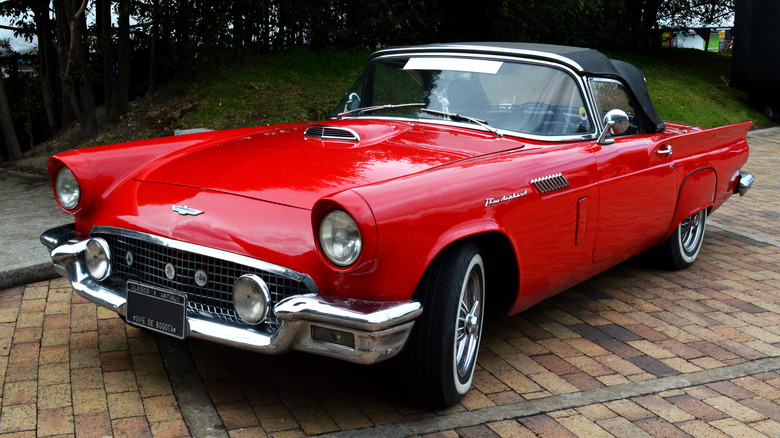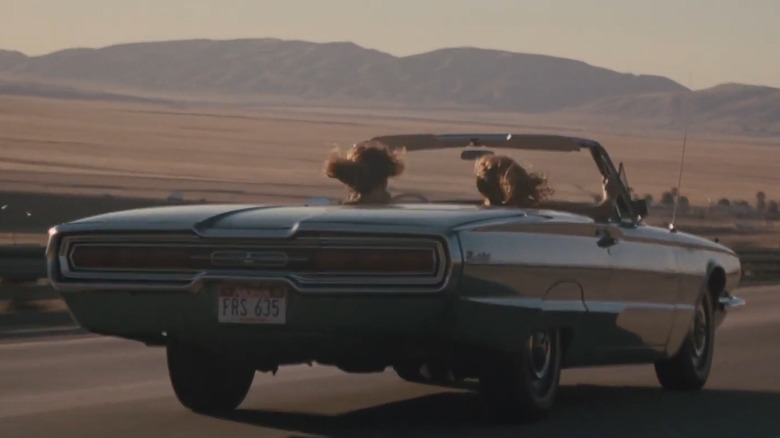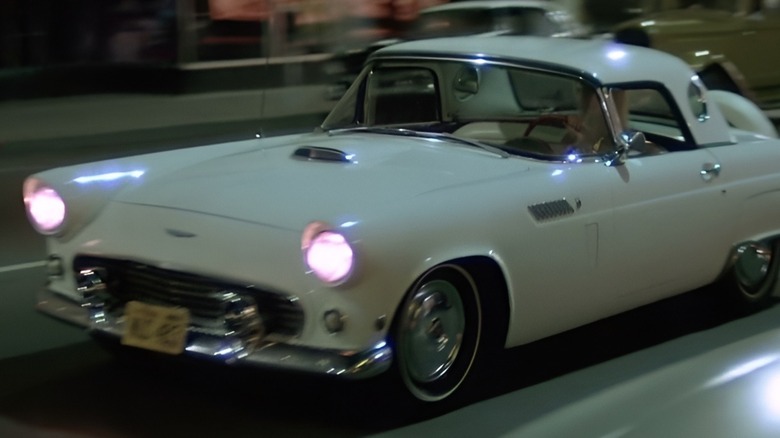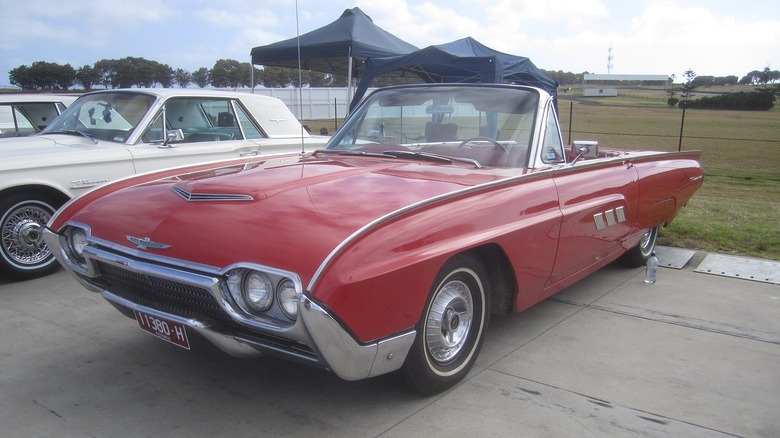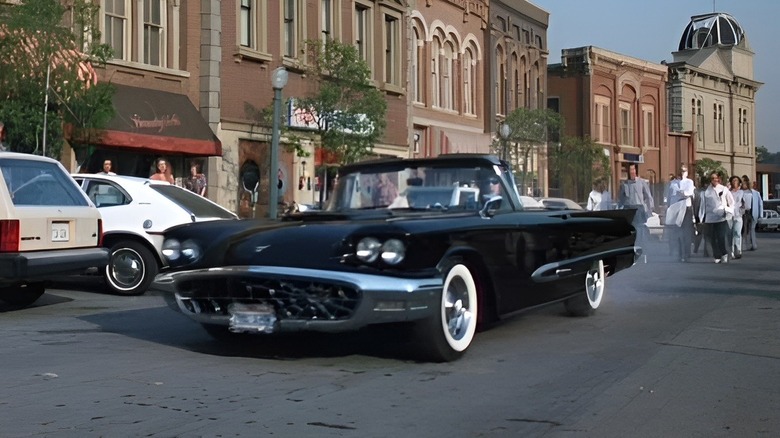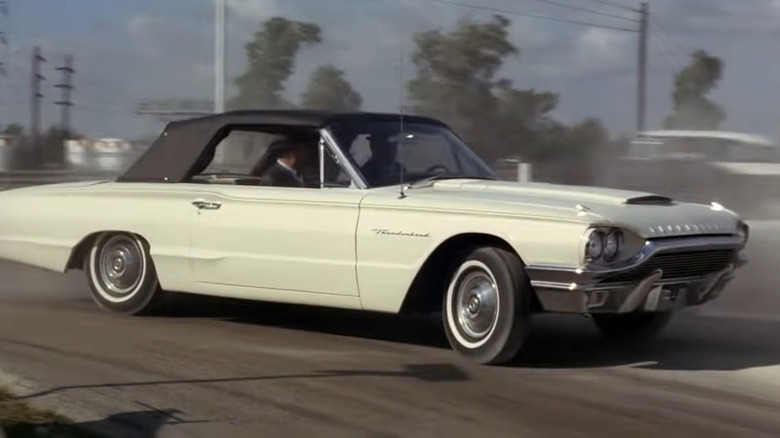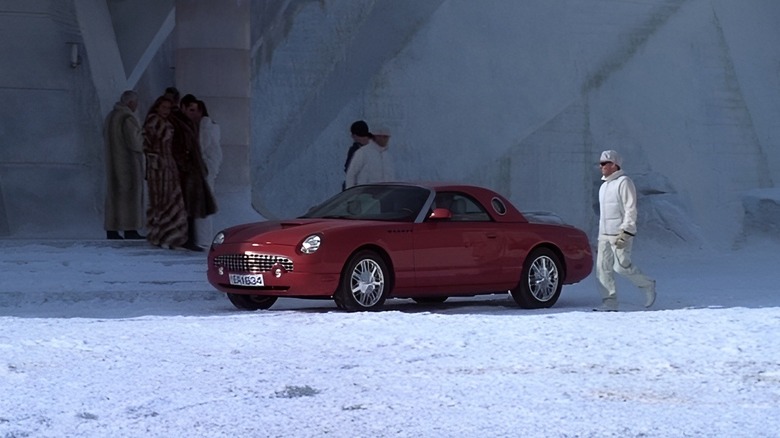6 Of The Most Iconic Appearances Of The Ford Thunderbird In Movies
Whether you love them or hate them, there's no denying that Ford has produced some striking rides over the years. In the mid 1950s, the manufacturer produced one of its most visually striking vehicles with the Ford Thunderbird. Created by George Walker and Louis D. Crusoe, the Thunderbird was introduced as a two-seater convertible and would continue to evolve with greater seating options, various accessories, and more powerful engines for eleven generations, ending its run in 2005. It would go on to introduce the personal luxury segment to the market, which placed an emphasis on comfort and style over the performance common in most sports vehicles.
With such a unique place in car history, it's no surprise that the Ford Thunderbird has etched out its own special place in the pop culture. Part of what has contributed to the iconography of the Thunderbird are its many moments on the big screen. Whether given as prominent a role as the main characters or only seen on the side in a scene or two, the Thunderbird leaves a lasting impression when on the screen. Its slick style and range of abilities opens the door to endless cinematic possibilities, which has led to some movie-Thunderbirds becoming especially notable. Let's take a ride down memory lane as we recount some of the most iconic Thunderbirds to ever grace the silver screen.
1966 Ford Thunderbird in Thelma and Lousie
It's hard to think of many movie cars that go beyond simply functioning as lavish eye candy and achieve some level of emotional resonance. The 1966 Ford Thunderbird featured in the 1991 "Thelma and Louise" may not do this in a traditional sense, but as the film goes on, it becomes apparent that this mean machine manages to carry some of the story's thematic relevance.
The Oscar-winning crime drama sees the titular best friends on the run from the authorities following Louise's (Susan Sarandon) murder of a man who was attempting to assault Thelma (Geena Davis). The two make a plan to make a daring escape to Mexico in Louise's 1966 Thunderbird. As they come across an array of shifty characters and evade the hands of the law, their hunger for freedom grows more intense, leading to ever more desperate feats of defiance to avoid a miserable life behind bars. This culminates in the movie's iconic final moments where (spoiler alert), among being cornered by the police, they launch their car over the edge of the Grand Canyon.
The final freeze-frame showing the Thunderbird shooting over the cliffside is an image that's hard to forget, giving the car itself greater meaning as the literal vessel that harbors the spirit of our heroes' liberation. In reality, the production stands as a testament to the power and durability of the Thunderbird. Only five Thunderbirds were used, a far lesser number than most films of this type, with none of them receiving any modifications. The famous final scene only required two takes, with the final take being completed in under an hour.
1956 Ford Thunderbird in American Graffiti
Before forever changing the pop culture landscape as we know it with the galaxy far, far away, George Lucas took audiences on a nostalgic trip back to a far less distant time and place with the 1973 coming of age classic "American Graffiti." With the film taking inspiration from Lucas' experiences as a teen amidst 1960s era California cruiser culture, the cars of "American Graffiti" play a dynamic role in imbuing "American Graffiti" with much of its character.
Among these cars is a white 1956 Ford Thunderbird driven by a mysterious blonde played by Suzanne Somers who captures the heart of Richard Dreyfuss' Curt Henderson. Although he is successful at getting a phone call with her after putting out a message on the radio, he never learns of her identity nor gets to see her the following day due to having to fly to college. However, he is given a sign of hope as he spots the white Thunderbird driving below his plane as it takes off.
With the cars in the movie acting as extensions of their drivers, it's hard to think of a vehicle that better represents the elegance and purity of the "Blonde in the T-Bird" as this classic ride. Following the success of the initial 1955 Thunderbird, Ford didn't make extensive changes for the following model year. The most noteworthy was the inclusion of a continental-style rear bumper made to hold the spare tire as a way of cutting down on trunk space, which in turn helped the car achieve better balance.
1963 Ford Thunderbird Sports Roadster in Flubber
Disney took the bird in Thunderbird literally for the 1997 Robin Williams comedy "Flubber." The movie sees Williams' Professor Philip Brainard create a special rubber substance that has the ability to make objects fly. At one point, he uses it on his 1963 Ford Thunderbird Roadster, which he takes on a flight across the town at night. After getting married at the end of the film, he flies the car again, this time with his new wife Sara, as they make way to their honeymoon.
There may not be as many layers to the reasoning behind the use of a Thunderbird here as some of the other movies on this list, but given that "Flubber" acts as a remake of the 1961 film "The Absent-Minded Professor," it could simply be an homage to that era of vehicles. The third generation Thunderbird in particular has been associated with some key figures of that decade, such as being featured heavily in John F. Kennedy's inaugural parade and one of the first Roadsters being owned by Elvis Presley.
As the final model year of the Thunderbird's third generation, many of the styling sensibilities from prior years were carried over, with a more pronounced emphasis on sleekness. This generation saw the introduction of the Sports Roadster, a limited edition Thunderbird fitted with 48 spoke Kelsey Hayes designed wire wheels, a removable hardtop, and an aerodynamic design made to strike a balance between style and performance.
[Featured image by Sicnag via Wikimedia Commons | Cropped and scaled | CC BY-SA 2.0]
1959 Ford Thunderbird Convertible in Elvira: Mistress of the Dark
When Cassandra Peterson's beloved TV horror hostess Elvira took her first steps on the big screen for the 1988 "Elvira: Mistress of the Dark," she and the team wanted to make sure the character's larger-than-life gothic persona was on full display. This is especially evident in her bold black 1959 Ford Thunderbird which, while initially being used partially due to production constraints, has become forever linked to the imagery and iconography of Elvira.
Peterson came across a black second generation Thunderbird in Hollywood and deemed it a fitting pick for her character. The problem was that the production budget wouldn't allow the team to purchase a classic Thunderbird convertible. So instead, they obtained a less expensive, more beaten-up 1959 hardtop model and converted it into a permanent convertible by fully removing the top. The car, which was given the name the Macabre Mobile, was given further alterations to match Elvira's campy, spooky aesthetic, including a spider web grille, leopard print upholstery, a rearview mirror surrounded by barbed wire, and skull decor in the center of the steering wheel.
Given that Peterson didn't have a garage to house the perpetual convertible and the car's condition was so poor to begin with, she chose to part ways with it by the end of production. The car was auctioned off to photographer Lynne Goldsmith, who returned it to Peterson many years later after moving to New York City. It went through further modifications over the years, including a notable makeover in a 2016 episode of History Channel's "Counting Cars."
1964 Ford Thunderbird Convertible in Goldfinger
The James Bond franchise has had a long history of placing the famous British agent and his many friends and foes behind the wheels of some revered classic cars. The 1964 "Goldfinger" was perhaps the entry that solidified this reputation, with such rides as the Aston Martin DB5, Lincoln Continental, and the Ford Mustang among many others getting their time to shine in the film. One of the most notable vehicles to be featured was a 1964 Wimbledon White Ford Thunderbird.
Driven by Cec Linder's Felix Leiter, the fictional car comes with a built-in tracking system used to pursue another villain who ends up evading them by destroying their car in a junkyard. "Goldfinger" would be the first James Bond movie to have Ford provide cars for promotional reasons. As a result, it's no surprise that the new-for-1964 Thunderbird would find its way into the movie. The car featured a blacktop convertible and was powered by a 390 cubic inch V8 engine along with a three-speed automatic Cruise-O-Matic gearbox.
Likely in part thanks to the financial success of "Goldfinger," sales for that year's Thunderbird would sell over 92,000 models. Encouraged by this, the following year would see the 1965 Thunderbird appear in the next Bond film "Thunderball" while a Thunderbird Landau showed up in 1971's "Diamonds are Forever."
2002 Ford Thunderbird in Die Another Day
"Die Another Day" released in 2002 and marked some notable milestones for the long-running franchise. It would end up being Pierce Brosnan's final time playing Bond and marked the character's 20th film appearance. Acting as a celebration of 40 years of Bond's big screen legacy, "Die Another Day" went all out with in capturing the essence of the franchise's classic entries. This is evident in the brief but noteworthy appearance of what was Ford's newest Thunderbird at the time, which would unknowingly also be the last of this legendary lineup.
Rather than being used by Bond himself, the car is driven by the movie's leading lady Jinx, played by Halle Berry, who uses it to reach the base of the movie's villain Gustav Graves, portrayed by Toby Stephens. Ford formed a lucrative product placement agreement with the film's producers, which lined up perfectly with the manufacturer's revival of the Thunderbird after a five-year hiatus. Aiming to evoke a nostalgic sense with a retro design, it's easy to see why Ford would want a Thunderbird featured in the Bond film that similarly aimed to give off a classic feel.
During the film's release, Ford put out a limited edition run of 700 specially-designed Thunderbirds made to replicate the one used in the film. They featured a number of unique differences that set it apart from typical production models, the most noteworthy being the rich "Sunset Coral" coloration made to match with the bikini worn by Berry's character. Sadly, Bond nor Berry were enough to get viewers excited about the Thunderbird which, following declining sales in the years that followed, ceased production in 2005.
